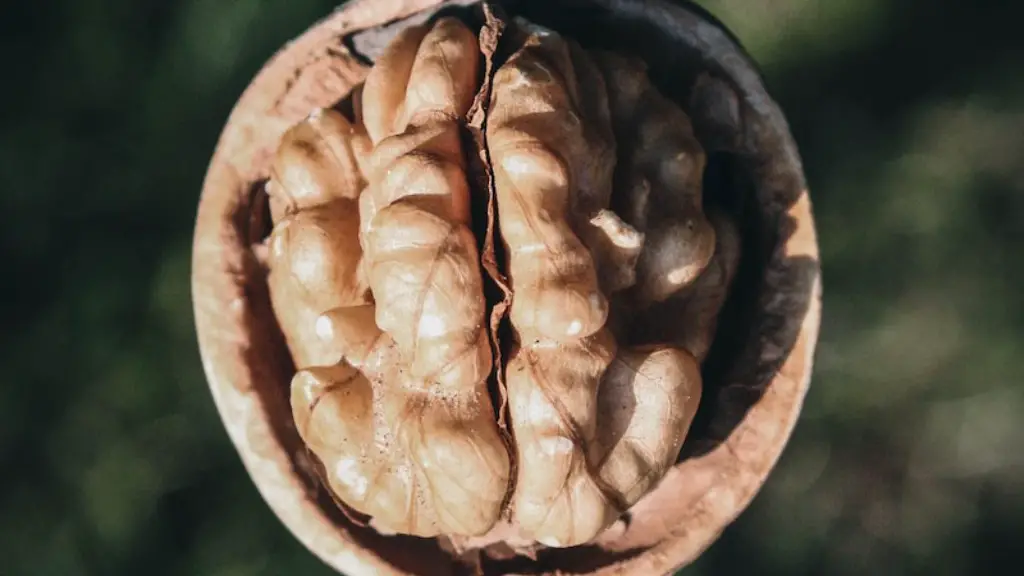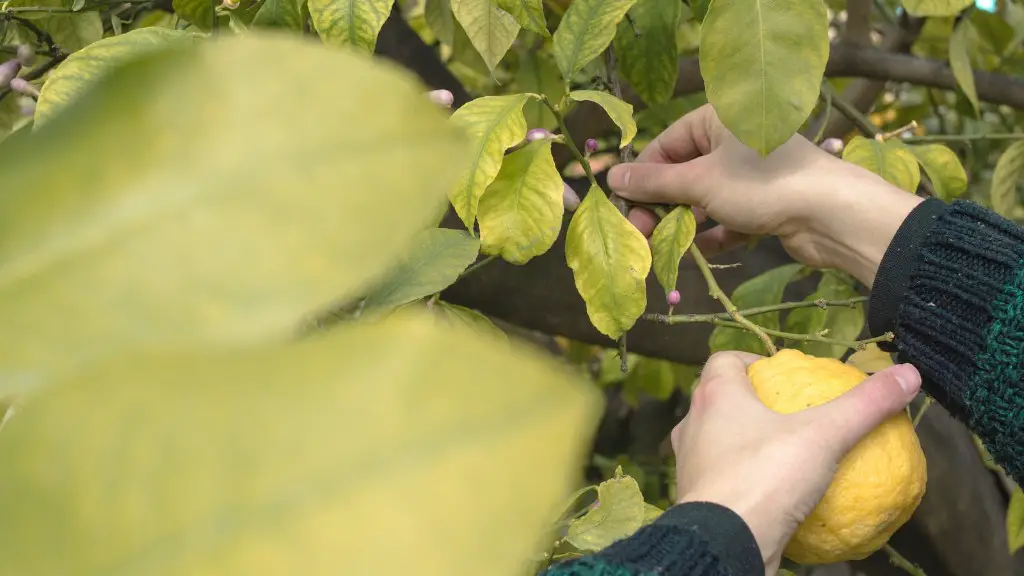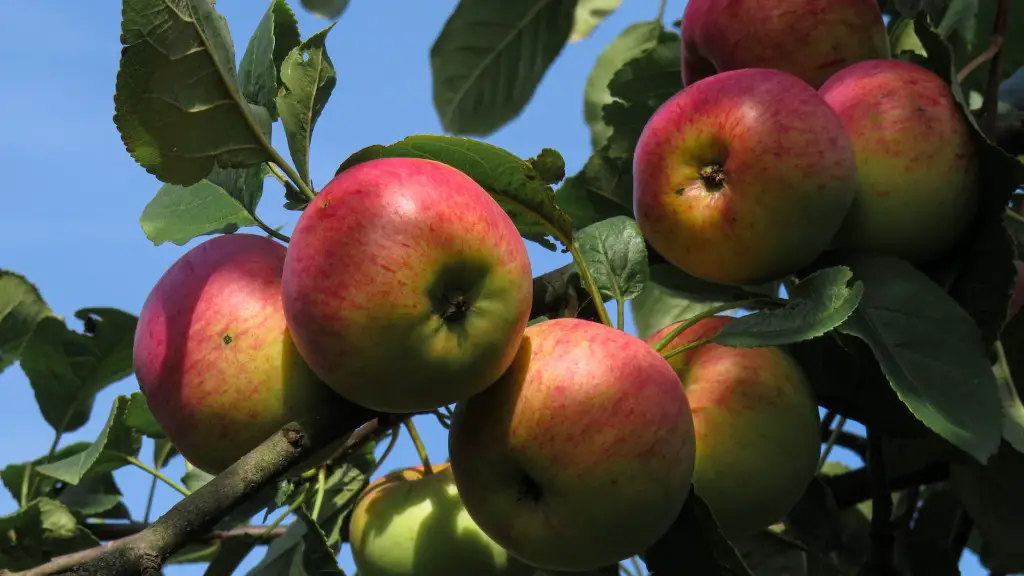Growing an apple tree is an exciting experience for those with the resources and patience to care for them. Here are a few tips that will help guide you through the process.
Firstly, get the right apple tree for your area. Many apple trees are bred to suit certain climates, so be sure to purchase a variety suited to yours. Certain apples do better in different parts of the country, so consider soil type and elevation when selecting an apple tree.
Second, know your tree’s needs. Most apple trees that do well will thrive in soil with full sun and proper water and fertilizer needs. Be sure to purchase and use fertilizer specifically designed for apple trees; they need specific nutrients and minerals to keep them healthy.
Third, prune your tree regularly. Pruning helps keep the tree healthy, strong, and encourages maximum fruit production. Be sure to trim your tree when it’s young and maintain it after it’s established.
Fourth, keep pests and diseases at bay. Apple trees can be susceptible to numerous pests and diseases, so watch out for infestation and signs of disease and address quickly. Many gardening centers can identify pest and diseases and recommend ways to treat them.
Fifth, use pesticides with discretion. Pesticides are used to ward off pests, but over-use of pesticides can do more harm than good for your tree. Before using any kind of pesticide, consider other remedies such as manual removal of pests and using natural remedies.
Sixth, water your apple tree consistently. Water your tree regularly to keep the soil moist. Allow the top inch of the soil to dry out between watering sessions. However, be sure to not overwater, as too much water can do more harm than good.
Planting the Apple Tree
A key to successful apple tree growth is the proper planting of the tree. Plant in the spring when the soil is warm, usually around late March or early April. Choose a spot that is sunny and sheltered from prevailing winds, but with plenty of airflow.
Pick a spot with soil that is well-drained; avoid areas that become soggy after rain or watering. With sandy soils, you may need to add some organic material to aid with retention of water and nutrients. Dig a hole twice as wide as the root system and fill it with a mixture of soil, fertilizer, and well-rotted compost. Plant the apple tree at the same depth it was growing previously.
Firm the soil around the roots and leave a shallow saucer of soil at the base of the tree. Mulch around the tree to lock in moisture, make weeding easier, and keep soil spores at bay. Water the tree well after planting and make sure there is some kind of support in place for the tree, such as wooden stakes or a trellis.
Caring for the Apple Tree After Planting
Once the tree is planted, the key to success lies in proper maintenance throughout the season. Monitor your apple tree for signs of stress and take prompt action. Whenever the top inch of soil feels dry, water the tree; aim for a couple of gallons of water once every 7-10 days. Keep an eye out for pests and diseases and address as soon as you see them.
Prune your tree in the late winter or early spring and consider thinning the fruit when it’s bearing. Thin, or thinning, involves pruning some of the fruit to encourage better, larger fruit. Make sure to feed your tree with fertilizer specifically designed for apple trees. Lastly, make sure to wax the apples after thinning and to protect from diseases and pests with proper pesticide applications.
Harvesting and Storing the Apples
When the time comes and your apple tree is full of fruit, be sure to get ready for harvesting. Under-ripe apples tend to be sour and unappetizing, so wait until the apples are fully ripe before plucking them off the tree. Try to pick apples that come away easily with a gentle tug. Avoid bruising the apples while handling them.
After you’ve harvested your apples, be sure to store them correctly. Use a cloth bag and store in a cool and dry place- such as a fridge- to prolong their life. Any apples that are damaged, diseased, or have been eaten by pests should be discarded. Apples freeze wonderfully, so you can store them for up to six months for use later.
Planting an Apple Tree in Containers
Growing smaller, dwarfed varieties of apples in containers is a great way to enjoy a bounty of apples in a limited space. The same principles of growing apples trees apply, only changes to the process include the use of containers and the need to water the apple tree a bit more often.
When selecting an apple tree to grow in a pot, ensure the tree is grafted onto a rootstock, as these trees tend to be smaller and better suited for pots. Select a large pot- one or two feet in diameter- and fill it with a quality mix of compost, soil, perlite, and sand. Place the apple tree in the container and water it thoroughly, ensuring all the soil around it is saturated.
Place the container in an area that gets 6-8 hours of sunlight and be sure to place a saucer of some kind beneath it to capture any water that may leak out. Monitor the water level and add more as needed, as containers tend to dry out more quickly than garden soil. Make sure the container has proper support and protect from pests and diseases with proper pesticide applications.
Including Other Companion Plants in the Apple Tree Environment
Aside from proper care, planting companion plants helps to ensure your apple tree remains healthy. Planting a range of plants that help to repel or distract pests and attract predators to the area is a great way to protect your tree. Consider planting herbs like lavender, rosemary, thyme and mint in and around your apple tree, as these produce scent and oils that help to ward off pests.
Plants like borage, calendula, yarrow, and clover to attract beneficial insects like ladybugs and other pollinators that will help apples to grow and flourish. Planting these companion plants around the tree also helps to supply additional nutrients and minerals that help to enrich your tree.
Be mindful of where you plant your companion plants for efficient harvest. Consider planting larger plants such as squash, melons, and cucumbers in areas where they can take the support of your apple tree’s branches. You can also plant other fruiting plants such as plums, peaches, and cherries to create a mini orchard within your yard.
Wrapping Up
Growing an apple tree is a rewarding experience that requires time, effort, and resources. Make sure to select the right variety for your area and pay attention to soil type, elevation, and climate. Prune your tree regularly, keep an eye out for signs of pests and diseases, and use pesticides with caution. Plant in the spring and include other companion plants for an ideal eco-system.
Water the tree at least once a week and use fertilizer specifically designed for apple trees. Know when to harvest the apples and store them correctly in a cool, dry place such as a fridge. Most importantly, enjoy your bounty and get creative with your apples!




